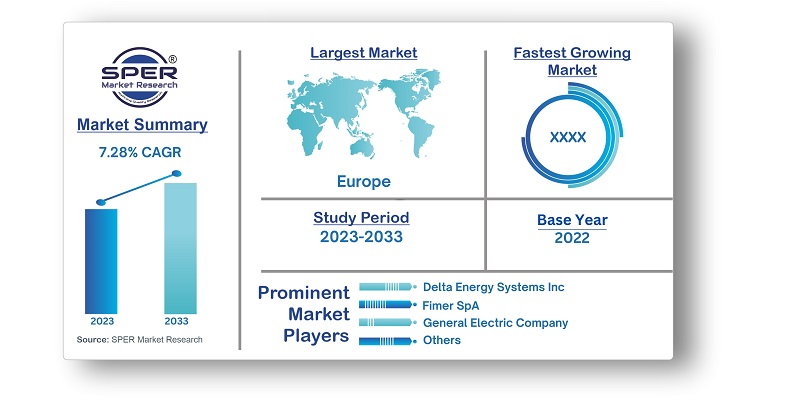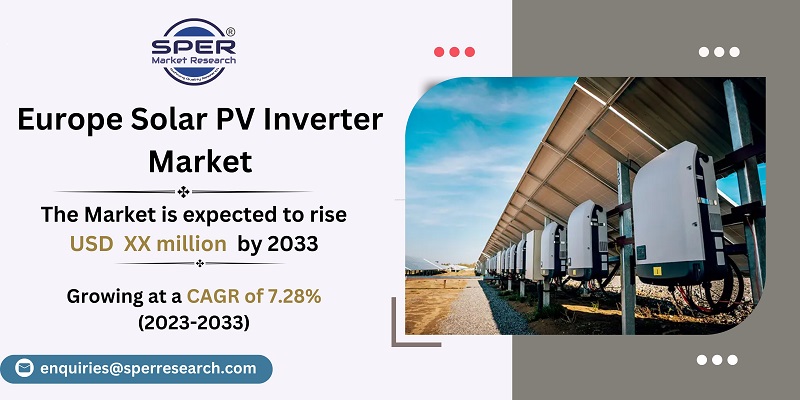
Europe Solar PV Inverter Market Growth, Share, Size, Trends, Revenue, Demand and Future Outlook
Europe Solar PV Inverter Market Size- By Type, By Application- Regional Outlook, Competitive Strategies and Segment Forecast to 2033
| Published: Feb-2024 | Report ID: POAE2417 | Pages: 1 - 155 | Formats*: |
| Category : Power & Energy | |||
- In June 2022: SMA Solar Technology AG declared its intention to construct a solar inverter production plant in Niestetal, Germany. The corporation plans to treble its manufacturing capacity from 21 GW as of 2021 to 40 GW by 2024, which includes the construction of a new gigawatt factory. It is anticipated that work will begin by the end of 2022.
- In April 2022: SMA Solar Technology AG introduced four new solar inverter models with a maximum power output of 135 kW for use in both residential and commercial PV systems. With ratings of 12 kW, 15 kW, 20 kW, and 25 kW, the new Sunny Tripower-X models come equipped with three separate MPP trackers, six-string inputs, and a dedicated system manager.


| Report Metric | Details |
| Market size available for years | 2020-2033 |
| Base year considered | 2023 |
| Forecast period | 2024-2033 |
| Segments covered | By Type, By Application |
| Regions covered | Germany, United Kingdom, France, Spain, Rest of Europe |
| Companies Covered | Delta Energy Systems Inc., Fimer SpA, General Electric Company, Huawei Technologies Co Ltd., KACO New Energy GmBH, Mitsubishi Electric Corporation, Omron Corporation, Schneider Electric SE, Siemens AG, SMA Solar Technology AG, Others. |
- Residential Consumers
- Commercial Enterprises
- Industrial Users
- Utility Companies
- Government Agencies and Regulators
- Energy Consultants and Analysts
- Renewable Energy Associations and Advocacy Groups
- Financial Institutions and Investors
- Solar PV Inverter Manufacturers and Suppliers
| By Type: |
|
| By Application: |
|
| By Region: |
|
- Europe Solar PV Inverter Market Size (FY’2023-FY’2033)
- Overview of Europe Solar PV Inverter Market
- Segmentation of Europe Solar PV Inverter Market By Type (Central Inverters, String Inverters, Micro Inverters)
- Segmentation of Europe Solar PV Inverter Market By Application (Residential, Commercial & Industrial, Utility-Scale)
- Expansion Analysis of Europe Solar PV Inverter Market
- Problems and Obstacles in Europe Solar PV Inverter Market
- Competitive Landscape in the Europe Solar PV Inverter Market
- Impact of COVID-19 and Demonetization on Europe Solar PV Inverter Market
- Details on Current Investment in Europe Solar PV Inverter Market
- Competitive Analysis of Europe Solar PV Inverter Market
- Prominent Players in the Europe Solar PV Inverter Market
- SWOT Analysis of Europe Solar PV Inverter Market
- Europe Solar PV Inverter Market Future Outlook and Projections (FY’2023-FY’2033)
- Recommendations from Analyst
1.1. Scope of the report1.2. Market segment analysis
2.1. Research data source2.1.1. Secondary Data2.1.2. Primary Data2.1.3. SPER’s internal database2.1.4. Premium insight from KOL’s2.2. Market size estimation2.2.1. Top-down and Bottom-up approach2.3. Data triangulation
4.1. Driver, Restraint, Opportunity and Challenges analysis4.1.1. Drivers4.1.2. Restraints4.1.3. Opportunities4.1.4. Challenges4.2. COVID-19 Impacts of the Europe Solar PV Inverter Market
5.1. SWOT Analysis5.1.1. Strengths5.1.2. Weaknesses5.1.3. Opportunities5.1.4. Threats5.2. PESTEL Analysis5.2.1. Political Landscape5.2.2. Economic Landscape5.2.3. Social Landscape5.2.4. Technological Landscape5.2.5. Environmental Landscape5.2.6. Legal Landscape5.3. PORTER’s Five Forces5.3.1. Bargaining power of suppliers5.3.2. Bargaining power of buyers5.3.3. Threat of Substitute5.3.4. Threat of new entrant5.3.5. Competitive rivalry5.4. Heat Map Analysis
6.1. Europe Solar PV Inverter Market Manufacturing Base Distribution, Sales Area, Product Type6.2. Mergers & Acquisitions, Partnerships, Product Launch, and Collaboration in Europe Solar PV Inverter Market
7.1. Europe Solar PV Inverter Market Value Share and Forecast, By Type, 2024-20337.2. Central Inverters7.3. String Inverters7.4. Micro Inverters
8.1. Europe Solar PV Inverter Market Value Share and Forecast, By Application, 2024-20338.2. Residential8.3. Commercial & Industrial8.4. Utility-Scale
9.1. Europe Solar PV Inverter Market Size and Market Share
10.1. Europe Solar PV Inverter Market Size and Market Share By Type (2020-2026)10.2. Europe Solar PV Inverter Market Size and Market Share By Type (2027-2033)
11.1. Europe Solar PV Inverter Market Size and Market Share By Application (2020-2026)11.2. Europe Solar PV Inverter Market Size and Market Share By Application (2027-2033)
12.1. Europe Solar PV Inverter Market Size and Market Share By Region (2020-2026)12.2. Europe Solar PV Inverter Market Size and Market Share By Region (2027-2033)12.3. Germany12.4. United Kingdom12.5. France12.6. Spain12.7. Rest of Europe
13.1. Delta Energy Systems Inc.13.1.1. Company details13.1.2. Financial outlook13.1.3. Product summary13.1.4. Recent developments13.2. Fimer SpA13.2.1. Company details13.2.2. Financial outlook13.2.3. Product summary13.2.4. Recent developments13.3. General Electric Company13.3.1. Company details13.3.2. Financial outlook13.3.3. Product summary13.3.4. Recent developments13.4. Huawei Technologies Co Ltd.13.4.1. Company details13.4.2. Financial outlook13.4.3. Product summary13.4.4. Recent developments13.5. KACO New Energy GmBH13.5.1. Company details13.5.2. Financial outlook13.5.3. Product summary13.5.4. Recent developments13.6. Mitsubishi Electric Corporation13.6.1. Company details13.6.2. Financial outlook13.6.3. Product summary13.6.4. Recent developments13.7. Omron Corporation13.7.1. Company details13.7.2. Financial outlook13.7.3. Product summary13.7.4. Recent developments13.8. Schneider Electric SE13.8.1. Company details13.8.2. Financial outlook13.8.3. Product summary13.8.4. Recent developments13.9. Siemens AG13.9.1. Company details13.9.2. Financial outlook13.9.3. Product summary13.9.4. Recent developments13.10. SMA Solar Technology AG13.10.1. Company details13.10.2. Financial outlook13.10.3. Product summary13.10.4. Recent developments13.11. Others
SPER Market Research’s methodology uses great emphasis on primary research to ensure that the market intelligence insights are up to date, reliable and accurate. Primary interviews are done with players involved in each phase of a supply chain to analyze the market forecasting. The secondary research method is used to help you fully understand how the future markets and the spending patterns look likes.
The report is based on in-depth qualitative and quantitative analysis of the Product Market. The quantitative analysis involves the application of various projection and sampling techniques. The qualitative analysis involves primary interviews, surveys, and vendor briefings. The data gathered as a result of these processes are validated through experts opinion. Our research methodology entails an ideal mixture of primary and secondary initiatives.



Frequently Asked Questions About This Report
PLACE AN ORDER
Year End Discount
Sample Report
Pre-Purchase Inquiry
NEED CUSTOMIZATION?
Request CustomizationCALL OR EMAIL US
100% Secure Payment






Related Reports
Our Global Clients
Our data-driven insights have influenced the strategy of 200+ reputed companies across the globe.




















